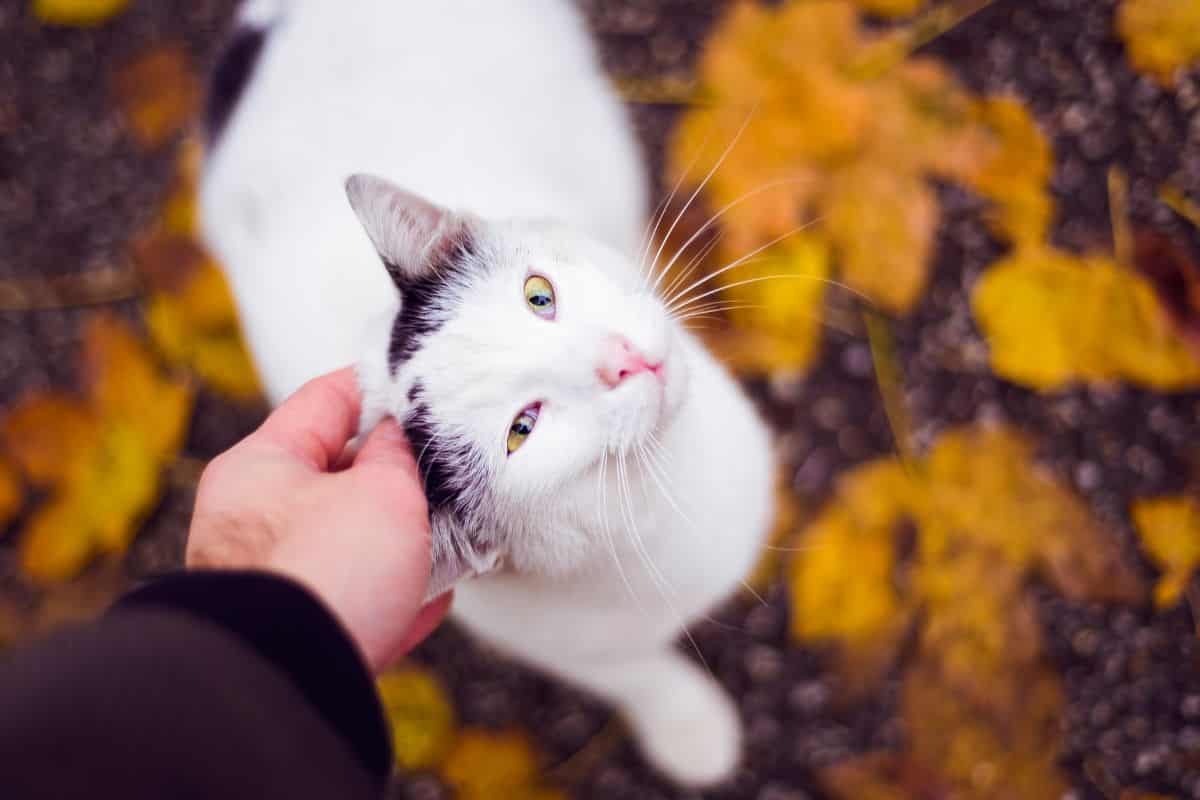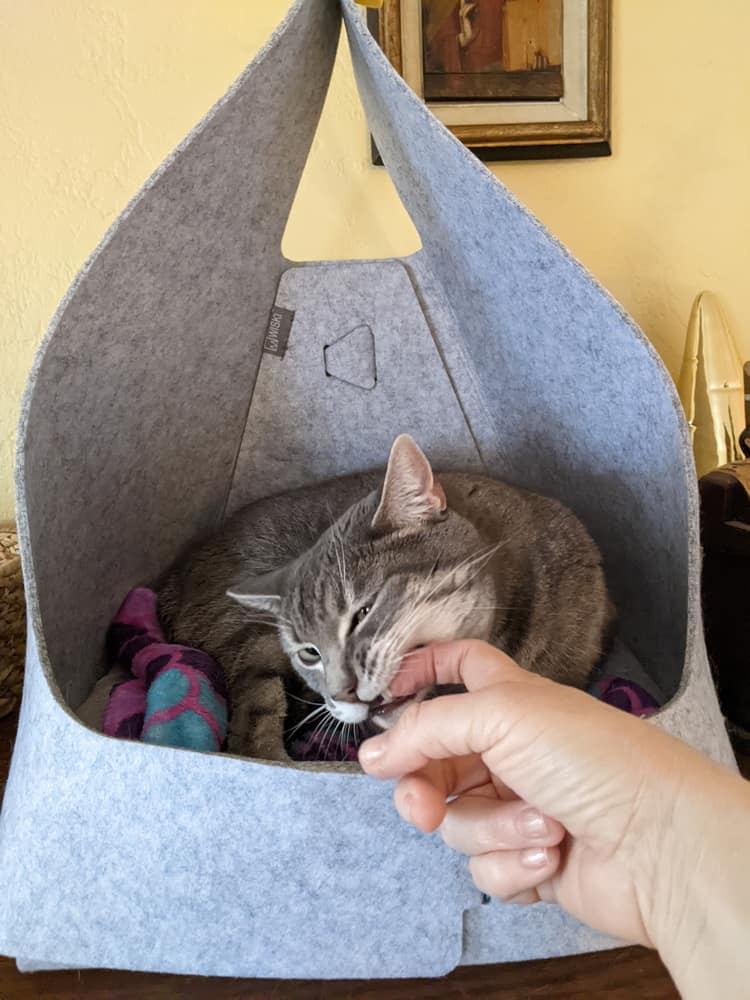Petting a cat can be a relaxing and enjoyable experience for both the feline and the person doing the petting.
When petting a cat, it’s important to be mindful and respectful towards the f
First see if the cat wants to be pet
Kind in mind that not all cats enjoy a lot of physical interaction. Cats are individuals. Their personalities, how socialized they were as kittens, and any past history (both positive and negative) will affect how much, or if, a cat will enjoy being pet.
So, the first thing you should do before reaching out a hand to pet a cat, is to get a sense of how receptive that cat is to your attempts at affection.
First, hold out the back of your hand towards the cat’s face. Smell is an important way that cats collect information about other beings and their environment.

Be patient and see if the cat wants to smell your hand. If the cat backs away or shows any tense body language, now is not the time to try and pet them.
If the cat seems relaxed and they are interested in smelling your hand, you can move on to trying some soft pets.
Start slowly
You will want to move your hand slowly towards the cat to start petting them. Use your fingertips to pet the cat’s fur, rather than your whole hand. Avoid petting the cat too hard, as this can be uncomfortable and even painful for the cat.
The most common areas around the face that a cat enjoys being pet is the chin, back of the neck, and the top of the head.

While you are slowly and lightly petting the cat, make sure to observe the body language. If the cat is enjoying being pet, they will often lean into the hand that is petting them. Purring is another sign of contentment.
If the cat is responding positively to your petting around their face, you can slowly move on to petting the cat along their body. Avoiding petting cats you don’t know around their tail, stomach, and paws as these tend to be sensitive areas for felines and most cats don’t like being pet in those areas.
When to stop petting
Pay attention to the tail which often is the first sign of a cat who is getting upset. If the cat’s tail drops low and starts swishing back and forth, that’s a signal from the cat that they don’t like what you are doing.
A tense body or the movement of the cat away from your is another sign the cat doesn’t like the attention.
if the cat begins to tense up, hiss, or swat at your hand, it is a sign that they are uncomfortable and you should stop petting them immediately.
Signs that the cat is not enjoying being pet by you:
- A low tail that is swishing back and forth
- Ears that are flattened inside of upright and relaxed
- No physical response to your petting them – most cats will reaction physically if they are happy with being pet such as kneading, head-butting, leaning in to the pet, and purring
- Moving away from you
- Lip licking: when a cat licks their lips, it’s often a sign that they are uncomfortable
- Growing or hissing in response to your hand moving toward them
- Biting or trying to scratch you
End the petting session when the cat signals it’s time.

Cats are independent animals, and they will let you know when they have had enough petting by changing their body language. Pay attention to the cat’s body language, and when they begin to move away or walk away, it is time to stop petting them.
Signs that a cat is enjoying being petted

Here are some signs that a cat is enjoying being petted:
- Purring: A cat will often purr when they are relaxed and happy
- Relaxed body: If the cat’s body is relaxed, with their muscles loose and their tail relaxed, it is a sign that they are happy
- Relaxed eyes: cats will lower their eyelids when they are enjoying being pet.
- Rolling around: a cat enjoying being pet may roll around or rub their chin across objects near by to show their enjoyment
- Kneading: Cats will sometimes knead their paws on a surface, such as a blanket or your lap, when they are feeling happy and content.
- Slow blinking: A slow and prolonged blink from a cat directed at you is a sign your cat is telling you that they like you
- Raised tail: A raised tail can indicate that the cat is happy and enjoying the attention.
- Nudging or head-butting: If your cat butts their head against you, it’s a sign they are happy with your presence and want you to continue petting them
Step-by-step guide on how to pet a cat
- Approach the cat slowly and calmly: Move towards the cat in a slow and non-threatening manner. Give the cat time to adjust to your presence and to sniff you.
- Let the cat sniff your hand: Offer the back of your hand for the cat to sniff. This will help the cat feel more comfortable and secure with your presence.
- Start with a gentle touch: Once the cat seems comfortable, begin petting them gently, starting with their head or chin. Use the tips of your fingers to stroke the fur, avoiding the sensitive belly and tail area.
- Pay attention to the cat’s body language: Observe the cat’s body language while you are petting them. If the cat is relaxed and appears to be enjoying the petting, you can continue. If the cat seems uncomfortable or begins to tense up, stop petting them immediately.
- Avoid petting for too long: Cats have a limited attention span and may become bored if petted for too long. Limit petting sessions to a few minutes at a time, and always end the session when the cat signals that they have had enough.
- Use a calm and soothing tone: While petting the cat, use a calm and soothing tone to help the cat feel relaxed and at ease.
It’s important to remember that every cat is different, and some cats may enjoy being petted more than others. Pay attention to the cat’s body language and always stop petting them if they seem uncomfortable or if they signal that they have had enough.







